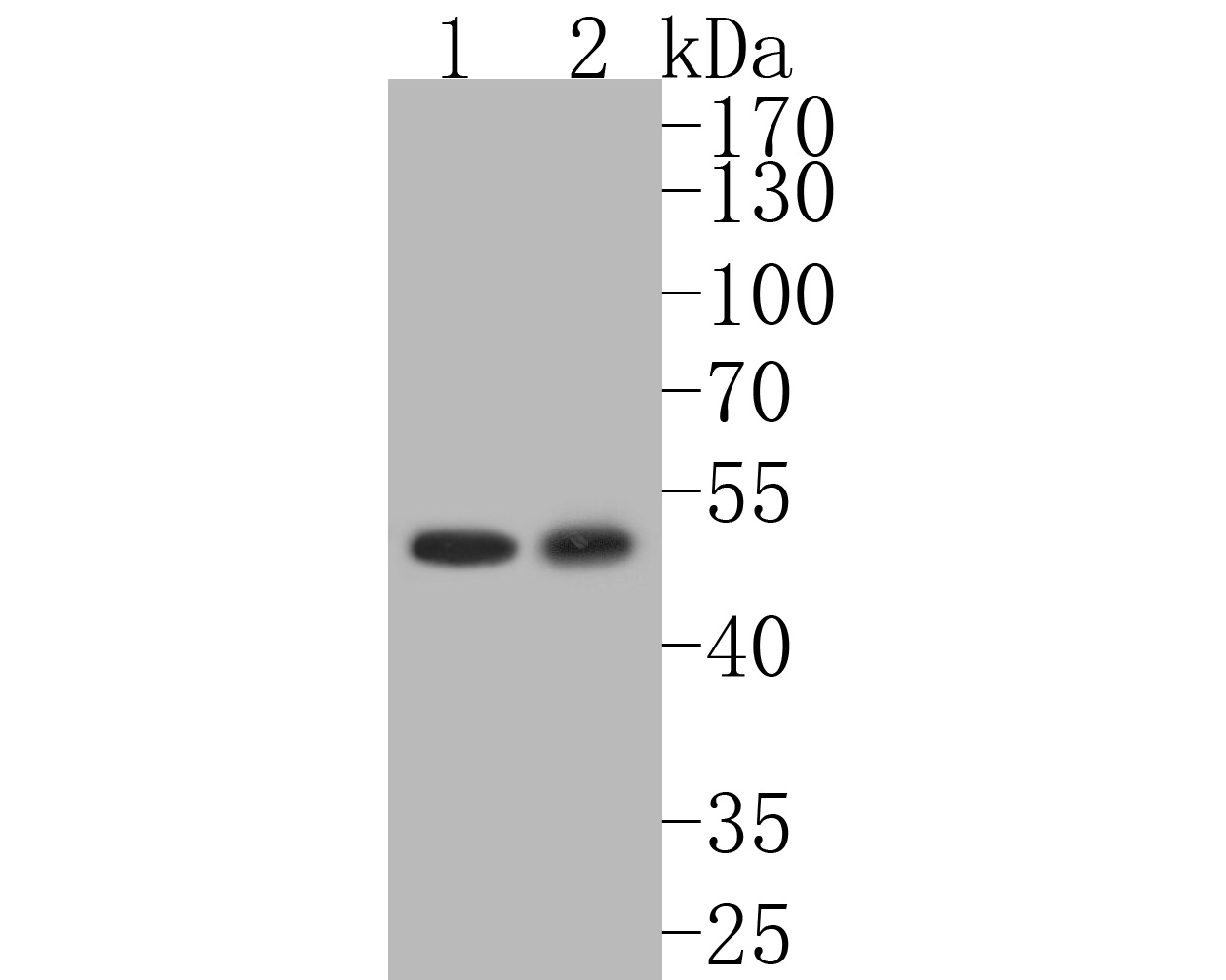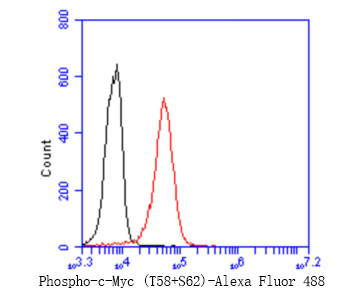
Rabbit Anti-phospho-C-Myc (Thr58+Ser62)antibody
Myc(Phospho-Thr58+Ser62); Myc(Phospho-T58+S62); p-Myc(Thr58+Ser62); p-Myc(T58+S62); AU016757; Avian myelocytomatosis viral oncogene homolog; bHLHe39; c Myc; Cellular myelocytomatosis oncogene; MGC105490; MRTL; Myc protein; Myc proto oncogene protein; Myc-
View History [Clear]
Details
Product Name phospho-C-Myc (Thr58+Ser62) Chinese Name 磷酸化致癌基因C-MycRecombinant rabbit monoclonal anti Alias Myc(Phospho-Thr58+Ser62); Myc(Phospho-T58+S62); p-Myc(Thr58+Ser62); p-Myc(T58+S62); AU016757; Avian myelocytomatosis viral oncogene homolog; bHLHe39; c Myc; Cellular myelocytomatosis oncogene; MGC105490; MRTL; Myc protein; Myc proto oncogene protein; Myc-related translation/localization regulatory factor; Myc2; myca; Myelocytomatosis oncogene a; Myelocytomatosis oncogene; Niard; Nird; Oncogene Myc; Protooncogene homologous to myelocytomatosis virus; RNCMYC; Transcription factor p64; Transcriptional regulator Myc-A; v myc avian myelocytomatosis viral oncogene homolog; v myc myelocytomatosis viral oncogene homolog (avian); V-Myc avian myelocytomatosis viral oncogene homolog; v-myc myelocytomatosis viral oncogene homolog (avian); zc-myc; MYC_HUMAN. Product Type Phosphorylated anti Recombinant rabbit monoclonal anti Research Area Tumour immunology Signal transduction transcriptional regulatory factor Kinases and Phosphatases Immunogen Species Rabbit Clonality Monoclonal Clone NO. 2B11 React Species Human, Rat, (predicted: Mouse, ) Applications WB=1:300-500 IHC-P=1:100-500 IHC-F=1:20-200 ICC=1:20-200 IF=1:20-200 (Paraffin sections need antigen repair)
not yet tested in other applications.
optimal dilutions/concentrations should be determined by the end user.Theoretical molecular weight 49kDa Cellular localization The nucleus Form Liquid Concentration 1mg/ml immunogen KLH conjugated Synthesised phosphopeptide derived from human c-Myc around the phosphorylation site of Thr58 and Ser62: LP(p-T)PPL(p-S)PS Lsotype IgG Purification affinity purified by Protein A Buffer Solution 0.01M TBS(pH7.4) with 1% BSA, 0.03% Proclin300 and 50% Glycerol. Storage Shipped at 4℃. Store at -20 °C for one year. Avoid repeated freeze/thaw cycles. Attention This product as supplied is intended for research use only, not for use in human, therapeutic or diagnostic applications. PubMed PubMed Product Detail The protein encoded by this gene is a multifunctional, nuclear phosphoprotein that plays a role in cell cycle progression, apoptosis and cellular transformation. It functions as a transcription factor that regulates transcription of specific target genes. Mutations, overexpression, rearrangement and translocation of this gene have been associated with a variety of hematopoietic tumors, leukemias and lymphomas, including Burkitt lymphoma. There is evidence to show that alternative translation initiations from an upstream, in-frame non-AUG (CUG) and a downstream AUG start site result in the production of two isoforms with distinct N-termini. The synthesis of non-AUG initiated protein is suppressed in Burkitt's lymphomas, suggesting its importance in the normal function of this gene. [provided by RefSeq, Jul 2008].
Function:
Participates in the regulation of gene transcription. Binds DNA in a non-specific manner, yet also specifically recognizes the core sequence 5'-CAC[GA]TG-3'. Seems to activate the transcription of growth-related genes.
Subunit:
Efficient DNA binding requires dimerization with another bHLH protein. Binds DNA as a heterodimer with MAX. Interacts with TAF1C and SPAG9. Interacts with PARP10. Interacts with KDM5A and KDM5B. Interacts (when phosphorylated at Thr-58 and Ser-62) with FBXW7. Interacts with PIM2 (By similarity). Interacts with NO66.
Subcellular Location:
Nucleus, nucleoplasm. Nucleus, nucleolus.
Post-translational modifications:
Phosphorylated by PRKDC. Phosphorylation at Thr-58 and Ser-62 by GSK3 is required for ubiquitination and degradation by the proteasome. Phosphorylation at Ser-329 by PIM2 leads to the stabilization of MYC (By similarity). Phosphorylation at Ser-62 by CDK2 prevents Ras-induced senescence.
Ubiquitinated by the SCF(FBXW7) complex when phosphorylated at Thr-58 and Ser-62, leading to its degradation by the proteasome. In the nucleoplasm, ubiquitination is counteracted by USP28, which interacts with isoform 1 of FBXW7 (FBW7alpha), leading to its deubiquitination and preventing degradation. In the nucleolus, however, ubiquitination is not counteracted by USP28, due to the lack of interaction between isoform 4 of FBXW7 (FBW7gamma) and USP28, explaining the selective MYC degradation in the nucleolus. Also polyubiquitinated by the DCX(TRUSS) complex.
DISEASE:
Note=Overexpression of MYC is implicated in the etiology of a variety of hematopoietic tumors.
Note=A chromosomal aberration involving MYC may be a cause of a form of B-cell chronic lymphocytic leukemia. Translocation t(8;12)(q24;q22) with BTG1.
Defects in MYC are a cause of Burkitt lymphoma (BL) [MIM:113970]. A form of undifferentiated malignant lymphoma commonly manifested as a large osteolytic lesion in the jaw or as an abdominal mass. Note=Chromosomal aberrations involving MYC are usually found in Burkitt lymphoma. Translocations t(8;14), t(8;22) or t(2;8) which juxtapose MYC to one of the heavy or light chain immunoglobulin gene loci.
Similarity:
Contains 1 basic helix-loop-helix (bHLH) domain.
SWISS:
P01106
Gene ID:
4609
Database links:Entrez Gene: 4609 Human
Entrez Gene: 17869 Mouse
Omim: 190080 Human
SwissProt: P01106 Human
SwissProt: P01108 Mouse
Unigene: 202453 Human
Unigene: 2444 Mouse
Unigene: 12072 Rat
Product Picture
Positive control:
Lane 1: K562 cell lysate
Lane 2: SH-SY5Y cell lysate
Flow cytometric analysis of Phospho-c-Myc (T58+S62) was done on K562 cells. The cells were fixed, permeabilized and stained with the primary antibody (SLM-52145R, 1/50) (red). After incubation of the primary antibody at room temperature for an hour, the cells were stained with a Alexa Fluor 488-conjugated Goat anti-Rabbit IgG Secondary antibody at 1/1000 dilution for 30 minutes.Unlabelled sample was used as a control (cells without incubation with primary antibody; black).
References (0)
No References
Bought notes(bought amounts latest0)
No one bought this product
User Comment(Total0User Comment Num)
- No comment




 +86 571 56623320
+86 571 56623320
 +86 18668110335
+86 18668110335

